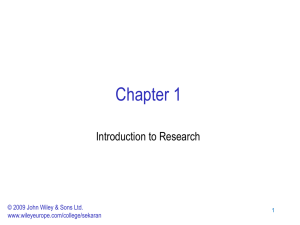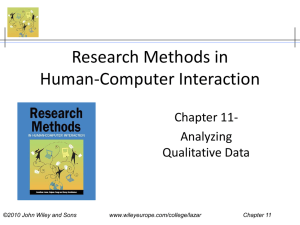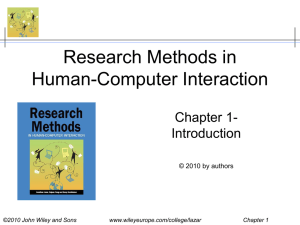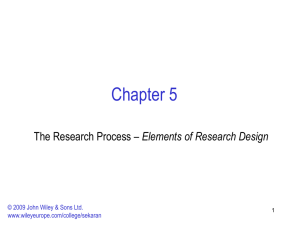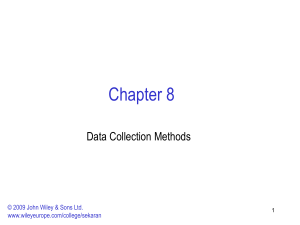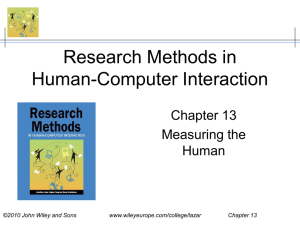ch04 - Interactive Computing Lab
advertisement
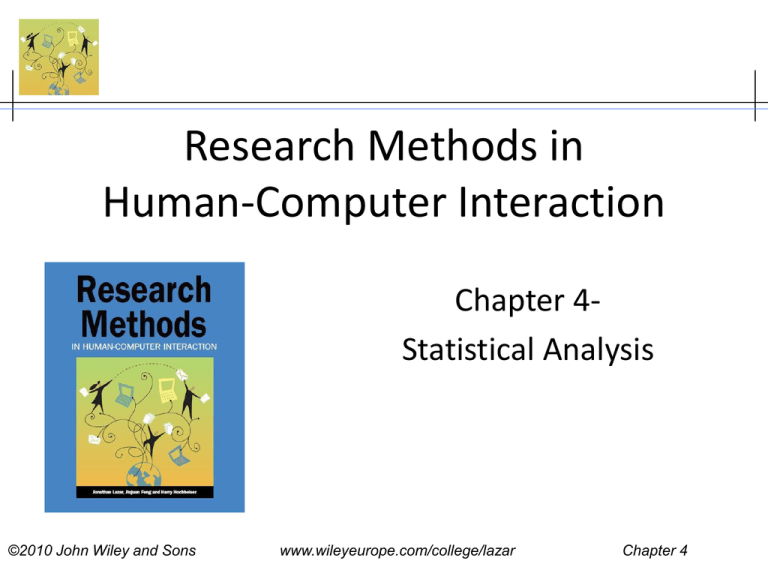
Research Methods in Human-Computer Interaction Chapter 4Statistical Analysis ©2010 John Wiley and Sons www.wileyeurope.com/college/lazar Chapter 4 Overview • • • • • • • • • Preparing data for statistical analysis Descriptive statistics Comparing means T tests Analysis of variance (ANOVA) Assumptions of t tests and F tests Identifying relationships Regression Nonparametric statistical tests ©2010 John Wiley and Sons www.wileyeurope.com/college/lazar Chapter 4 Preparing data for analysis • Cleaning up data – Detect errors – Formatting • Coding – Types of data that need to be coded – Be consistent • Organizing the data – Accommodate to the requirements of statistical software ©2010 John Wiley and Sons www.wileyeurope.com/college/lazar Chapter 4 Descriptive statistics • Measures of central tendency – Mean – Median – Mode • Measures of spread – Range – Variance – Standard deviations ©2010 John Wiley and Sons www.wileyeurope.com/college/lazar Chapter 4 Comparing means • Summary of methods ©2010 John Wiley and Sons www.wileyeurope.com/college/lazar Chapter 4 Comparing 2 means: T tests • Independent-samples t test: between-group design ©2010 John Wiley and Sons www.wileyeurope.com/college/lazar Chapter 4 Comparing 2 means: T tests • Paired-sample t test: within-group design ©2010 John Wiley and Sons www.wileyeurope.com/college/lazar Chapter 4 Comparing 2 or more means: Analysis of variance (ANOVA) • Also called F tests • One-way ANOVA: for between-group design • Data layout: Table 4.6 • Results summary: ©2010 John Wiley and Sons www.wileyeurope.com/college/lazar Chapter 4 ©2010 John Wiley and Sons www.wileyeurope.com/college/lazar Chapter 4 Factorial ANOVA • For between-group design • 2 or more independent variables involved • Data layout: table 4.9 ©2010 John Wiley and Sons www.wileyeurope.com/college/lazar Chapter 4 ©2010 John Wiley and Sons www.wileyeurope.com/college/lazar Chapter 4 Factorial ANOVA • Summary results ©2010 John Wiley and Sons www.wileyeurope.com/college/lazar Chapter 4 Repeated measures ANOVA • For within-group design • Can investigate one or more variables • One-way ANOVA ©2010 John Wiley and Sons www.wileyeurope.com/college/lazar Chapter 4 Repeated measures ANOVA • One way ANOVA summary report: ©2010 John Wiley and Sons www.wileyeurope.com/college/lazar Chapter 4 Repeated measures ANOVA • Two way ANOVA experiment design: ©2010 John Wiley and Sons www.wileyeurope.com/college/lazar Chapter 4 Repeated measures ANOVA Two way ANOVA data layout ©2010 John Wiley and Sons www.wileyeurope.com/college/lazar Chapter 4 Repeated measures ANOVA • Two way ANOVA summary report: ©2010 John Wiley and Sons www.wileyeurope.com/college/lazar Chapter 4 Split-plot ANOVA • Involves both between-group and within-group factors • Experiment design ©2010 John Wiley and Sons www.wileyeurope.com/college/lazar Chapter 4 Split-plot ANOVA data layout ©2010 John Wiley and Sons www.wileyeurope.com/college/lazar Chapter 4 Split-plot ANOVA summary report ©2010 John Wiley and Sons www.wileyeurope.com/college/lazar Chapter 4 Assumptions of t tests and F tests • Errors should be independent of each other • Errors should be identically distributed • Errors should be normally distributed ©2010 John Wiley and Sons www.wileyeurope.com/college/lazar Chapter 4 Identify relationships • Correlation: Two factors are correlated if there is a relationship between them • Most commonly used test for correlation is the Pearson’s product moment correlation coefficient test • Pearson’s r: ranges between -1 to 1 • Pearson’s r square represents the proportion of the variance shared by the two variables ©2010 John Wiley and Sons www.wileyeurope.com/college/lazar Chapter 4 Identify relationships • Correlation does not imply causal relationship ©2010 John Wiley and Sons www.wileyeurope.com/college/lazar Chapter 4 Identify relationships • Regression: can investigate the relationship between one DV and multiple IVs • Regression is used for 2 purposes: – Model construction – Prediction • Different regression procedures – Simultaneous – Hierarchical ©2010 John Wiley and Sons www.wileyeurope.com/college/lazar Chapter 4 Non-parametric tests • Non-parametric tests are used when: – The error is not normally distributed – The distances between any two data units are not equal – The variance of error is not equal ©2010 John Wiley and Sons www.wileyeurope.com/college/lazar Chapter 4 Non-parametric tests • CHI-square test – Used to analyze categorical data – Table of counts (contingency table) – Assumptions of the test • Data points need to be independent • The sample size should not be too small ©2010 John Wiley and Sons www.wileyeurope.com/college/lazar Chapter 4 Non-parametric tests • Two groups of data – For between-group design: Mann–Whitney U test or the Wald–Wolfowitz runs test – For within-group design: Wilcoxon signed ranks test • Three or more groups of data – For between-group design: Kruskal–Wallis oneway analysis of variance by ranks – For within-group design: Friedman’s two-way analysis of variance test ©2010 John Wiley and Sons www.wileyeurope.com/college/lazar Chapter 4 End-of-chapter • Summary • Discussion questions • Research design exercise ©2010 John Wiley and Sons www.wileyeurope.com/college/lazar Chapter 4

